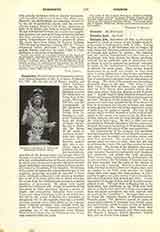

Common Life, BRETHREN OF THE, a community founded by Geert De Groote, of rich burgher stock, b. at Deventer in Gelderland in 1340; d. 1384. Having read at Cologne, at the Sorbonne, and at Prague, he took orders and obtained preferment—a canon’s stall at Utrecht and another at Aachen. His relations with the German Gottesfreunde and the writings of Ruysbroek, who later became his friend, gradually inclined him to mysticism, and on recovering from an illness in 1373 he resigned his prebends, bestowed his goods on the Carthusians of Arnheim, and lived in solitude for seven years. Then, feeling himself constrained to go forth and preach, he went from place to place calling men to repentance, proclaiming the beauty of Divine love, and bewailing the relaxation of ecclesiastical discipline and the degradation of the clergy. The effect of his sermons was marvelous; thousands hung on his lips. “The towns”, says Moll, “were filled with devotees; you might know them by their silence, their ecstasies during Mass, their mean attire, their eyes, flaming or full of sweetness.” A little band of these attached themselves to Groote and became his fellow-workers, thus becoming the first “Brethren of the Common Life”. The reformer, of course, was opposed by the clerks whose evil lives he denounced, but the cry of heresy was raised in vain against one who was no less zealous for purity of faith than for purity of morals. The best of the secular clergy enrolled themselves in his brotherhood, which in due course was approved by the Holy See. Groote, however, did not live long enough to perfect the work he had begun. He died in 1384, and was succeeded by Florence Radewyns, who two years later founded the famous monastery of Windesheim which was thenceforth the center of the new association.
The Confraternity of the Common Life resembled in several respects the Beghard and Beguine communities which had flourished two centuries earlier and were then decadent. The members took no vows, neither asked nor received alms; their first aim was to cultivate the interior life, and they worked for their daily bread. The houses of the Brethren were more closely knit together, and the brothers and sisters alike occupied themselves exclusively with literature and education, and priests also with preaching. When Groote began, learning in the Netherlands was as rare as virtue; the University of Louvain had not yet been founded, and the fame of the schools of Liege was only a memory. Save for a clerk here and there who had studied at Paris or Cologne, there were no scholars in the land; even amongst the higher clergy there were many who were ignorant of Latin, and the burgher was quite content if when his children left school they were able to read and write. Groote determined to change all this, and his disciples accomplished much. Through their unflagging toil in the scriptorium and afterwards at the press they were able to multiply their spiritual writings and to scatter them broadcast throughout the land, instinct with the spirit of the “Imitation”. Amongst them are to be found the choicest flowers of fifteenth-century Flemish prose. The Brethren spared no pains to obtain good masters, if necessary from foreign parts, for their schools, which became centers of spiritual and intellectual life; amongst those whom they trained or who were associated with them were men like Thomas a Kempis, Dierick Maertens, Gabriel Biel, and the Dutch Pope Adrian VI.
Before the fifteenth century closed, the Brethren of the Common Life had studded all Germany and the Netherlands with schools in which the teaching was given for the love of God alone. Gradually the course, at first elementary, embraced the humanities, philosophy, and theology. The religious orders looked askance at these Brethren, who were neither monks nor friars, but the Brethren found protectors in Popes Eugenius IV, Pius II, and Sixtus IV. The great Cardinal Nicholas of Cusa had been their pupil and became their stanch protector and benefactor. He was likewise the patron of Rudolph Agricola, who in his youth at Zwolle had sat at the feet of Thomas a Kempis; and so the Brethren of the Common Life, through Cusa and Agricola, influenced Erasmus and other adepts in the New Learning. More than half of the crowded schools—in 1500 Deventer counted over two thousand students—were swept away in the religious troubles of the sixteenth century. Others languished until the French Revolution, while the rise of universities, the creation of diocesan seminaries, and the competition of new teaching orders gradually extinguished the schools that regarded Deventer and Windesheim as their parent establishments. A life of De Groote is to be found among the works of Thomas a Kempis.
ERNEST GILLIAT-SMITH

